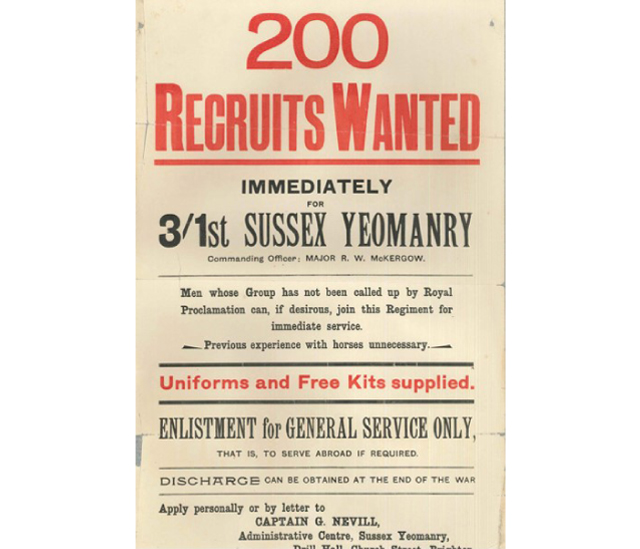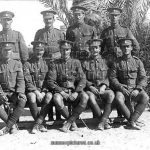One of the oldest of the Sussex military units, the Sussex Yeomanry, served with distinction during the First World War.
Yeomanry Regiments were composed of light cavalry soldiers and the Sussex Yeomanry was formed as a volunteer Cavalry Regiment in 1794 in response to the threat of invasion by Napoleon. The Regiment continued until 1848 in support of local authorities, as there was no national or local police enforcement when the regiment was disbanded.
The unit was reformed as the 69th (Sussex) Company of the Imperial Yeomanry in 1900, fighting in South Africa until 1902. After the Boer War, the Sussex Yeomanry continued in existence until the creation of the Territorial Force in 1908 when the Regiment was reformed as four Cavalry squadrons (18 localised Troops) and a headquarters in Brighton.
In April 1908, on re-formation, the unit was headquartered at Church Street in Brighton, with the squadrons (sqn) being headquartered as listed below, and under command of the South Eastern Mounted Brigade:
- A Sqn: Brighton (with drill stations at Horsham, Worthing, Haywards Heath and Crawley)
- B Sqn: Lewes (Brighton, Uckfield and Tunbridge Wells)
- C Sqn: Chichester (Bognor)
- D Sqn: Eastbourne (St Leonards, Bexhill and Rye)
Sussex Yeomanry during WW1
In the First World War, the Regiment was expanded first to two and later a third formation. It saw dismounted service in 1915 with the 1st battalion of the 1st regiment (1/1st) serving at Gallipoli and Palestine. On return from the Middle East it was incorporated in The Royal Sussex Regiment as the 16th Battalion. In 1917 the Regiment moved to the Western Front. The 2nd Battalion (2/1st) was initially a recruiting and training formation, but later served in Ireland and, as a result, the 3rd battalion (3/1st) was formed. However this battalion only existed for a short period of time and was soon disbanded following the incorporation of the 1st battalion into the Royal Sussex Regiment.
- Lewes Camp , 1914 – image courtesy of Sussex Yeomanry Regimental Association
- Lewes Camp , 1914 – image courtesy of Sussex Yeomanry Regimental Association
- 1st / 1st Sussex Yeomanry Sussex Yeomanry Sergeants (probably Canterbury 1915) – – image courtesy of Sussex Yeomanry Regimental Association
1/1st Sussex Yeomanry First World War participation timeline
- August 1914: moved with the brigade to South East Cavalry Depot in Canterbury.
- 24 September 1915 : dismounted, the brigade sailed on the “Olympic” from Liverpool to Gallipoli, landing on 8 October 1915 and coming under orders of 42nd (East Lancashire) Division.
- December 1915 / January 1916: withdrew from Gallipoli and moved to Mudros (Limnos Island, Greece).
- February 1916: moved to Egypt where brigade was absorbed into 3rd Dismounted Brigade on Suez Canal defences.
- July 1916: brigade moved to join the Western Frontier Force.
- 3 January 1917: converted to infantry, becoming 16th (Sussex Yeomanry) Battalion of the Royal Sussex Regiment and came under orders of 230th Brigade in 74th (Yeomanry) Division.
- 7 May 1918: landed at Marseilles and spent rest of war on Western Front.
2/1st Sussex Yeomanry First World War participation timeline
- Formed at Brighton in September 1914 as a “second line” (training, draft-supplying reserve) for the 1/1st.
- May 1915: moved to Maresfield (Wealden), came under orders of 2/1st Southern Mounted Brigade.
- October 1915: moved with brigade to Canterbury, where brigade came under orders of 4th Mounted Division.
- July 1916: converted to a cyclist unit in 5th Cyclist Brigade, under 2nd Cyclist Division, and moved to Great Bentley (Essex).
- November 1916: merged with 2/1st Surrey Yeomanry to form 8th (Surrey and Sussex) Yeomanry Cyclist Regiment, under command of 3rd Cyclist Brigade at Ipswich.
- March 1917: resumed original identity but in same brigade. Moved to Bromeswell Heath (near Woodbridge, Suffolk) by May 1917. Moved in October to nearby Grundisburgh (Suffolk).
- April 1918: moved to Ireland, being initially at Dublin but soon to Clandeboye (outside Belfast). In September 1918 moved to Boyle (Roscommon) where it then remained.
3/1st Sussex Yeomanry First World War participation timeline
- Formed as a “third line” (training, draft-supplying reserve for the 1/1st and 2/1st) in Brighton in July 1915.
- June 1915: affiliated to 3rd Reserve Cavalry Regiment at Canterbury.
- December 1916: disbanded. The men were posted to 1st/1st in Egypt, the 2/1st Sussex Yeomanry or the 5th Battalion of the Royal Sussex Regiment.
- Gallipoli (1st / 1st Sussex Yeomanry in theatre 1915) – image courtesy of Sussex Yeomanry Regimental Association
- Sussex Yeomanry C Co. (1st / 1st Sussex Yeomanry) Sergeants; probably Egypt on Canal Patrol Duties 1916 – image courtesy of Sussex Yeomanry Regimental Association
Battle Honours awarded to Sussex Yeomanry:
Somme 1918, Bapaume 1918, Hindenburg Line, Epéhy, Pursuit to Mons, France and Flanders 1918, Gallipoli 1915, Egypt 1916-17, Gaza, Jerusalem, Tell’ Asur, Palestine 1917-18
In the 1917 renumbering of the Territorial’s, the 2nd/1st Sussex Yeomanry issued numbers from the block 170001-175000, (the 1/1st were now part of the Royal Sussex Regiment and the 3/1st had been disbanded.)
After the war
In 1921 the Sussex Yeomanry was re-designated as field artillery becoming the 13th (Sussex Yeomanry) Army Brigade, Royal Field Artillery. In 1922 it was amalgamated with the Surrey Yeomanry and re-formed as the 98th (Surrey and Sussex Yeomanry) Brigade, Royal Field Artillery, becoming fully mechanised in 1928.
In 1939 and the outbreak of war, the Brigade was reorganised into two, two Battery Regiments of Field Artillery the 98th and 144th. The 98th was part of the British Expeditionary Force in the Second World War and was evacuated from Dunkirk later serving in North Africa including El Alamein and in Italy and Western Europe. The 144th served in a Home Defence role until 1941, before going to fight in Italian occupied Abyssinia. In 1942 they deployed to Iraq, Syria and Lebanon on internal security duties. The 144th also provided a cadre in 1940 to create 74th Medium Regiment Royal Artillery (RA), which fought in North Africa and Italy.
Subsequent to the Second World War; the regiment was reformed as 344th Regiment Light Anti-Aircraft, RA which, following several reorganisations in the 1950s and 60s, became 257 Sussex Yeomanry Regiment RA, with batteries in Worthing, Bexhill, Haywards Health and Brighton. This lasted until 1967.
In 1967, the Army was reorganised and the Sussex Yeomanry became a single Battery of 100 Medium Regiment RA, based in Brighton. This continued until 1992 when the unit was re-rolled as Royal Engineers as a 127 Squadron within 78 Fortress Engineer Regiment until 1999, when ‘Options for Change’ reduced the size of the Army.
The title today is carried by 1 Troop of 579 Field Squadron, Explosive Ordinance Disposal.
The Sussex Yeomanry Regimental Museum is located within Newhaven Fort.
Information for this story was provided by John Shill of the Sussex Yeomanry Regimental Association.













